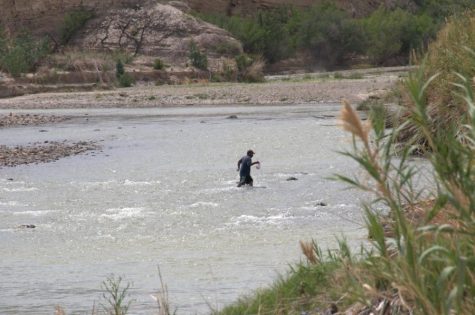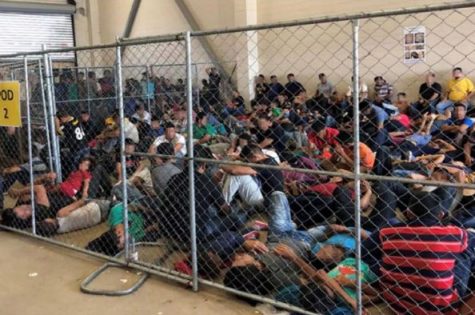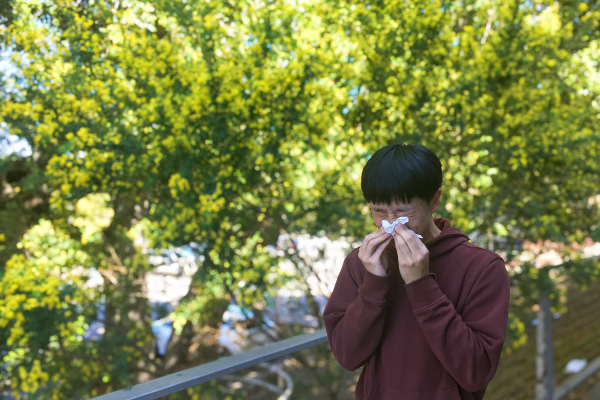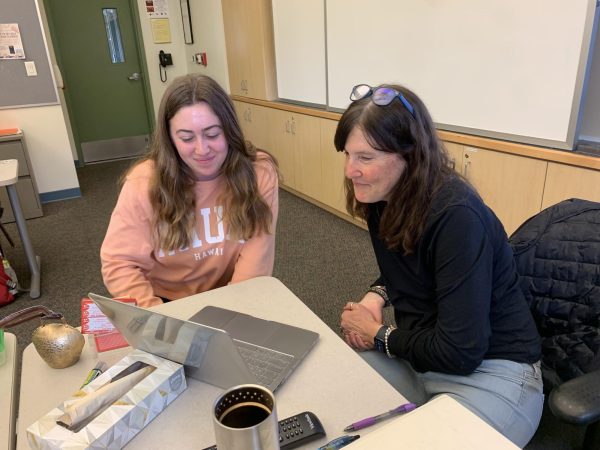The American dream: A journey to the land of opportunity
An immigrant faces life-threatening conditions throughout their journey to the U.S. An arid desert atmosphere and a lack of water pose significant threats to an immigrant’s life as they trek through the American Southwest.
January 21, 2021
For the past few decades, an increasing number of undaunted Central American migrants have crossed through Mexico on foot, truck bed, and railcar to reach what they hope will be a land of opportunity and a gateway to economic prosperity and stability. The grueling, arduous journey undertaken by tens of thousands of immigrants each month — from the jungles of Chiapas and Campeche to the desolate deserts of the Sonora — has become the defining allegory of the extensive movement of Central American migrants to the U.S.
Because economic and political instability pervades multiple Central American countries, U.S. immigration policies and practices have been aimed at preventing an influx of undocumented immigrants from its southern border, which in turn has complicated the journey of many asylum seekers and migrants. Among them, young people, in particular, have sought entry into the U.S. in increasing numbers, intent on fulfilling their wildest hopes and dreams. This article tells the story of one young person’s journey to the U.S. and explores the governmental policies that have framed his experience.
José’s story: A long way from home
Amazed by the differences between his current school and those he left behind, José* gazed upon the grandeur of the new high school campus and reflected upon how his life had changed so drastically in the past few months.
With only a rudimentary understanding of English, attending a new high school was a feat in itself. However, it was nothing compared to the sacrifice and hardship he endured during his journey to reach the U.S. in search of opportunity and financial freedom.
Born to a single mother in the oil-rich municipality of La Libertad, Guatemala, soccer and socializing were José’s two favorite pastimes. With 10 siblings and a neighborhood full of energetic youth, there was an abundance of company to keep him entertained.
However, during his time at school, the thirst for knowledge and learning escaped the young boy. Unmotivated and lacking a support system, his studies became a lower priority.
Notwithstanding the relative placidity present in his surrounding community, fundamental threats to the stability of Guatemala remained omnipresent. Reports of cartel violence were the main topics of discussion on local news channels, and incendiary headlines concerning the cartels were plastered along the sides of town newsstands.
“Almost every day, we heard of someone getting mugged. It could have been for a multitude of reasons; they could have a new car or a lot of money, and that made them a target for the cartels,” José said.
As local cartels began to recruit younger people to join their ranks, the idea of joining one was eschewed by many and thought to be a risk not worth taking.
José said, “[None of us] had siblings, close friends, or cousins who participated in cartel activities. We were normal, but those that joined the cartels, they changed for the worse.”
Cartels were unable to reach the youth at José’s school. However, other recruitment methods abounded, and “the streets” evolved into the primary medium by which gangs lured prospective members.
José said, “[Cartels] did not have a presence at my school. They only worked in the streets, under the cover of darkness.”
According to José, jobs in Guatemala were widely available, but meager wages and dismal working conditions ensured that families remained impecunious, preventing social mobility.
“[To earn a lot of money], you needed to have a good education or have gone to university, but many, to this day, don’t have that opportunity,” José said.
This lack of earning potential had a greater effect upon José than he could have imagined. José’s father, a fastidious laborer and stalwart supporter of the local community, immigrated to the U.S. a few months before José’s birth. Leaving José and his siblings in the care of José’s mother, his father set out towards the U.S.-Mexico border.
After a perilous journey through Mexico, José’s father crossed the U.S.-Mexico border. He bounced around the American Southwest, picking up odd jobs before making his way to the Bay Area and establishing a solid foundation upon which he could support his family back in Guatemala, first, with carefully-sealed envelopes filled with sundry denominations, and later, via bank transfer.
One of José’s sisters and one of his brothers followed suit shortly thereafter, leaving José with a smaller nuclear family and deep gratitude for his father’s actions.
“[My dad] came [to the United States] with the purpose of giving us a better life in Guatemala, and for that, I am forever grateful,” José said.
For an impressionable youth, never having the chance to meet his father took an emotional toll. Nights spent wide awake, José dreamed of his father and the defining moments of his childhood they were never able to share. He yearned for the chance to play soccer with his father, to drive down the gravel path near their home together, yet those opportunities never came.
“He was my father, yet I never was able to grow up with him beside me. I wanted to meet him; find out who he was,” José said.
Among other factors, economic incentives were a driving force behind the family’s decision to immigrate to the U.S. With visions of prosperity and financial stability, a reunion with family members, and the prospect of meeting his father, the allure proved too great for José to ignore.
In early 2019, José, one of his cousins, and his uncle uprooted their life in Guatemala and set out to join José’s father and other members of the family in the U.S.
The journey
Beginning their journey from a decrepit rest stop on the outskirts of La Libertad, Guatemala, the group drove for hours until they reached the Guatemalan border with Mexico. From there, the difficulties grew, and José was left to contemplate his decision to leave his hometown.
José said, “Leaving my family brought an awful feeling to my stomach. I had second thoughts about my journey, and at some points, I didn’t know if I could continue.”
To complete this journey, José had to push these initial worries to the back of his mind.
Crossing the Guatemalan border with Mexico was a dangerous task. To ensure a safe passage and evade the watchful eyes of the Mexican military, José’s uncle devised a system that reduced the risks associated with crossing the river that divided the two countries.
The water rushed furiously downstream, violently splashing against the slippery rocks that dotted the shores on each side of the river. The riverbanks themselves were rocky in parts, sandy in others.
Yellow life jackets, tethered together by homemade string, bobbed in the middle of the menacing body of water. The deep blue of the river, tinged with light purple in the calmest areas, frightened the boys.
José and his cousin looked across the river at José’s uncle, who had already made the crossing. He stood, patiently waiting for the boys to gather up the courage needed to cross the river.
Without warning, José’s uncle launched the life jackets into the air. José stretched his arm out, mustering all of his will, to catch the line of lifejackets. Once he caught and secured the lifejackets to his side of the river, José and his cousin navigated the river with relative ease.
Soon after, the group of three emerged from the depths of the jungle. After searching for adequate transportation, the trio settled on traveling by car. Crammed in the backseat of a Toyota Yaris for many hours, the group welcomed a chance to stretch their legs. After the break, the group began walking, eventually arriving at a hotel. Their first brush with law enforcement was quickly approaching.
“[Immigration officials] were going to deport us from Mexico, and that worried everyone in our group,” José said.
With members of the Mexican military on the prowl, José’s uncle thought it imperative to remain hidden from prying eyes, secretive about the true purpose of their journey. The trio stayed in the hotel room for a few days, biding their time as the government officials moved on to more pressing matters. They resumed their journey northward, and within a week, the trio had reached the U.S.-Mexico border, unprepared for the horrors they would soon face.
Stories from the past
Looking back on the ordeal, José realizes that, at the moment of his crossing into the U.S., his subconscious was working against him. Stories of apprehension and deportation near the Rio Grande had made the rounds in Guatemala, and those stories instilled a sense of fear in him that he would be unable to ignore.
In his new community in California, immigrants routinely shared their experiences crossing the U.S.-Mexico border. Soon after arriving at his new home in the Bay Area, José learned that his siblings’ crossings had not been without setbacks.
In an emotional conversation, José’s brother detailed how the pair of siblings crossed the U.S.-Mexico border. José’s brother, an able athlete, struggled with the strong current of the Rio Grande, and due to the rough conditions, he eventually was pushed underwater. José’s brother, gasping for one last breath of air before he was plunged into the watery depths, caught the attention of fellow immigrants, who helped pull the boy to safety.
After the harrowing river crossing, José’s brother and sister continued their journey to the Bay Area. In a journey that took six weeks to complete, food and water sources were few and far between. The pair encountered appalling conditions during their walk through the desert region of the American Southwest.
“They encountered the corpses of people who had perished on the journey before them. To sleep, they had to huddle together so they wouldn’t freeze to death,” José said.
Once José’s siblings reached the Bay Area, they were reunited with their father, with whom they shared a tearful embrace. José relishes in telling this story, an example of the family’s determination, but he now realizes the dangers he faced during his crossing of the Rio Grande. On that fateful day, he was blissfully unaware of the trials and tribulations his siblings had faced and of the dangers that lay before him.
Crossing the Rio Grande

Approaching the dispiriting river and famed entrance to the U.S., José stared across the body of water at the opposing riverbank. Immigrants rapidly scurried away, hiding from obtrusive searchlights behind concrete pillars.
José took his first step into the water. Ice-cold shock flowed through his body. Ignoring the sensory response, José submerged himself into the river and paddled against the current, water lapping against his glistening forehead as he kicked furiously.
Reaching the other bank relatively quickly, his first step onto American soil was purely euphoric. The emotions that washed over José reminded him of the reason he came to America.
José said, “I felt excited [at the prospect of] new opportunities, and I just wanted to meet my father.”
José joined his cousin and uncle at the bus stop. They waited to be transported to the nearest U.S. Immigration and Customs Enforcement (ICE) detention facility to turn themselves in to the authorities and request asylum.
Harm at the hands of ICE

Lines stretching for a city block greeted José’s group as they approached the ICE facility. José observed the surrounding area, enjoying his last few moments in the warm embrace of the sun.
As José entered the facility, the lack of color and stoic expressions worn by employees deeply unnerved him. At the moment, José perceived this to be a sign of a lack of emotion, but nothing could prepare him for the ensuing maltreatment by ICE officials over the course of the six days of his detention.
“When I came to the United States, [ICE agents] treated me very poorly. They woke up [the detainees] at 1 a.m., just to bother us, and they didn’t let us sleep much. They didn’t give us good food; they only gave us a bottle of water for the morning meal, and that was it,” José said.
Kept separated from José’s uncle, José and his cousin spent most of their days lying on the stone-cold concrete floor.
“It was a horrible experience. [ICE agents] kept you in a cell, like an animal. They kept you locked up, on the floor, and they didn’t give you anything to cover or shield yourself from the cold,” José said.
After the news of their arrival had reached the Bay Area, José’s father flew to the ICE facility and began filling out paperwork to secure the release of José, his cousin, and his uncle. The process was much more complicated than what the group had expected.
While José’s cousin and uncle were allowed to travel to California, José was transported to an orphanage in Miami to await the signing and notarization of legal documents. After a few days spent in the orphanage’s care, José boarded a plane to Northern California early in the morning. ICE agents kept a close eye on the boy, as they had throughout the entire process.
José said, “I think that [ICE agents] followed us, closely watching our movements.”
Arrival in the Bay Area
Upon his arrival to the Bay Area from Florida, José did everything he could to calm his nerves. He was finally going to be able to reunite with his father.
Pushing the notion of ICE pursuing him to the back of his mind, José was overwhelmed with emotion. Upon landing, José disembarked and was greeted by his father with a loving embrace.
José spent the next few days catching up with siblings, reminiscing about the journey and learning all he could about their new life in the Bay Area. He established himself as a humorous young man that fit right in with the local immigrant community. Shared experiences and hardships served as bonds between these immigrants, and José created newfound friendships with the kids in his neighborhood. Soon after, José enrolled at a local high school, which he began attending at the beginning of the fall semester of the 2019-2020 school year.
Having recently immigrated to the U.S. and speaking Spanish his entire life, José’s verbal English skills were undeveloped, and his writing skills were almost non-existent. On the first day of school, his feeling of uncertainty about the new environment was exacerbated by the language barrier.
José said, “I didn’t know English. I didn’t know what anyone was saying. I wasn’t able to understand anything.”
Despite his lack of English proficiency, José was grateful for the opportunities the school offered. In comparison to Guatemala, José had access to more resources and better education in the U.S.
“If you wanted a book [in Guatemala], you had to buy it with your own money. Here, it’s different, and I have access to computers for free,” José said.
José, a student who participates in an English Language Learner program at his school, struggled in this new environment before being thrust into a new predicament as the coronavirus (COVID-19) pandemic forced the closure of schools nationwide. The change has been difficult for him, and working from home presented new obstacles.
José said, “The pandemic has been challenging [in terms of my academics]. Online learning has changed the way I approach my schooling, and I’ve had difficulties with the internet and my computer a lot.”
In spite of these difficulties, José feels that he has a stronger understanding of the English language, mainly because he receives support from teachers and staff. Staff members that interact with José on a daily basis have noted his work ethic and resilient nature.
“He’s a go-getter; he doesn’t just sit back and wait. He goes out and makes things happen. He’s not a quitter; he does not give up,” said Jane Doe*, José’s teacher.
Doe pointed out that the obstacles inherent to distance learning impact those who are not native English speakers even more.
Doe said, “It’s really unfortunate for English learners to not have the full on-campus experience. It just makes everything a little more difficult.”
Notwithstanding these obstacles, Doe was confident that José would overcome them.
“He’s determined, patient, and he is able to adapt. He’s an excellent student, one who is fearless and not afraid to speak up,” Doe said.
That same support system and resilience are what pushed him to branch out and make new friends. José thought that the language barrier was too great to overcome initially, but now, he feels accepted within his school community due to the bonds he has created with students both within and outside of the English Language Learner program.
Despite his immersion in U.S. society, José tries to remain connected to his family members in Guatemala. His father still sends money to José’s siblings and mother every month, and they maintain sporadic and limited communication.
Other effects, such as the separation from his mother, have taken an enormous toll on José. Even though he expresses gratitude towards his father for his role in supporting the family during José’s childhood, José still misses his mother. The significant role she played in his childhood makes the separation all the more difficult to cope with.
“It was hard to leave [my family], especially my mom, because I spent the first 14 years of my life with her [in Guatemala]. She acted as my mother and my father because I didn’t know my father, so leaving her was extremely difficult,” José said.
Overall, José stressed that a set of compassionate and humanizing policies needed to be introduced. José highlighted the predicament that the U.S. immigration system puts immigrants in, one of choosing between a livelihood and their family.
“[One thing I would change about the U.S. immigration system] would be to allow my entire family to enter the country and be reunited with us, without fear of deportation,” José said.
In spite of his misgivings with the U.S. immigration system, José’s perception of the U.S. reflects the mindset of many Central American immigrants who choose to make the peregrination to the U.S.
José said, “The United States is a country of freedom and opportunity; it truly is a great country.”
*In accordance with Carlmont’s Anonymous Sourcing Policy, the names of the subject and his teacher have been changed to preserve the subject’s identity.
**The original interview with the anonymous source was conducted in Spanish. The author of this article translated the interview and had multiple outside sources verify the legitimacy and accuracy of the translation.
“The changing dynamic of Central American migration to the U.S.” is the continuation of this article. To read the second part of this feature article, click here.
This story was originally published on Scot Scoop News on January 19, 2021.































![IN THE SPOTLIGHT: Junior Zalie Mann performs “I Love to Cry at Weddings,” an ensemble piece from the fall musical Sweet Charity, to prospective students during the Fine Arts Showcase on Wednesday, Nov. 8. The showcase is a compilation of performances and demonstrations from each fine arts strand offered at McCallum. This show is put on so that prospective students can see if they are interested in joining an academy or major.
Sweet Charity originally ran the weekends of Sept. 28 and Oct. 8, but made a comeback for the Fine Arts Showcase.
“[Being at the front in the spotlight] is my favorite part of the whole dance, so I was super happy to be on stage performing and smiling at the audience,” Mann said.
Mann performed in both the musical theatre performance and dance excerpt “Ethereal,” a contemporary piece choreographed by the new dance director Terrance Carson, in the showcase. With also being a dance ambassador, Mann got to talk about what MAC dance is, her experience and answer any questions the aspiring arts majors and their parents may have.
Caption by Maya Tackett.](https://bestofsno.com/wp-content/uploads/2024/02/53321803427_47cd17fe70_o-1-1200x800.jpg)
![SPREADING THE JOY: Sophomore Chim Becker poses with sophomores Cozbi Sims and Lou Davidson while manning a table at the Hispanic Heritage treat day during lunch of Sept 28. Becker is a part of the students of color alliance, who put together the activity to raise money for their club.
“It [the stand] was really fun because McCallum has a lot of latino kids,” Becker said. “And I think it was nice that I could share the stuff that I usually just have at home with people who have never tried it before.”
Becker recognizes the importance of celebrating Hispanic heritage at Mac.
“I think its important to celebrate,” Becker said. “Because our culture is awesome and super cool, and everybody should be able to learn about other cultures of the world.”
Caption by JoJo Barnard.](https://bestofsno.com/wp-content/uploads/2024/01/53221601352_4127a81c41_o-1200x675.jpg)















